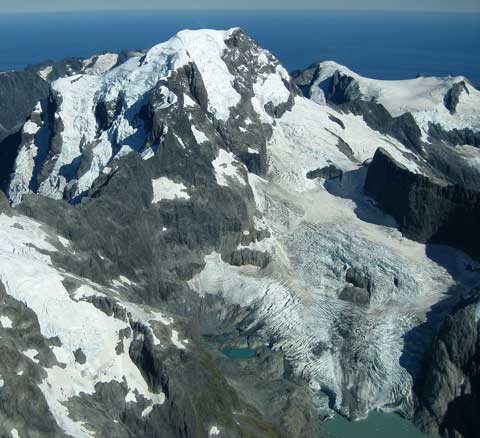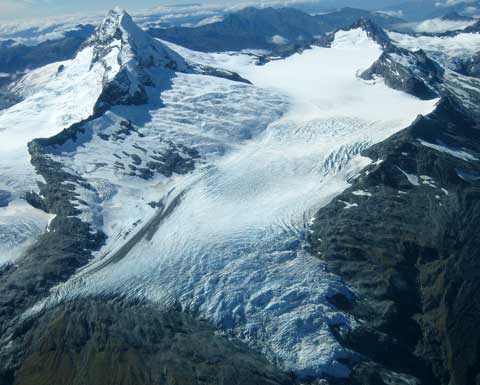
New Zealand’s glaciers are continuing to lose mass according to this year’s aerial survey of the Southern Alps by NIWA scientists. The figures released today show that over 2008-9 the glaciers lost much more mass through melt and calving than they gained from snowfall. From the press release:
NIWA Snow and Ice Scientist Dr Jordy Hendrikx says weather patterns over the course of the year from April 2008 to March 2009 meant that overall the glaciers had lost much more ice than they had gained. This was mainly due to the combination of above normal temperatures and near normal or below normal rainfall for the Southern Alps during winter, and La Niña-like patterns producing more northerly flows creating normal-to-above normal temperatures, above normal sunshine, and well below normal precipitation for the Southern Alps particularly during late summer.
NIWA have also released some of the wonderful pictures taken by Dr Hendrikx during the flights. The photo above shows Mt Tutoko (the highest mountain in Fiordland), with the Donne glacier tumbling down its flanks towards the Hollyford valley and calving into a lake. Below is Mt Aspiring with the Bonar glacier on the left. Must be one of life’s finer jobs — being paid to fly around the magnificent scenery of the nation’s spine. See also: TV One’s report on this year’s flights, and HT’s coverage of last year’s figures.


Whoops!…….. the deniers are going to have to find some real obscure glaciers now. A losing game when they just keep melting away.
I could hear Chris Defreitas slamming his fist onto his desk from here.
One of the deniers that visit this sight has stated that real scientists measure things not build models. Well here is measurement and it supports the models (also based on measurement).
I also see in this mornings Dom-post that a recent study indicates that the EAIS is losing mass. Not much at this stage but much earlier than was expected.
Damn those scientists measuring things it’s all part of the global science conspiracy (TM)
Re EAIS loss:
“A new study shows that the world’s largest ice shelf has lost almost 60 billion tonnes of ice per year for the past three years.”
60 Billion tonnes = 60 km^3 of water, (~66 km^3 of ice)
Volume of EAIS = ~20 million km^3
Time to melt at this rate = 300,000 years
Catastrophe Cancelled
Linear thinking from someone with little undeerstanding.
Steve, which part of the word “feedback” do you not understand?
http://www.global-greenhouse-warming.com/climate-feedback.html
http://www.bigpicture.tv/videos/watch/371bce7dc
In order for non-linear, positive feedbacks to cause catastrophic meltdown on Al-Gore type timescales, melting will have to increase at least a thousandfold. There is no credible mechanism that could cause such an outcome.
Al didn’t specify a time scale. That aside, how much sea level rise do you think will be catastrophic for the inhabitants of Bangladesh, the Mekong Delta, and the other Asian megadeltas? Half a metre should be enough to cause a lot of grief — and we could easily see that well within the next 100 years.
The ANDRILL team found that the Ross Ice Shelf has repeatedly collapsed when CO2 reached 400 ppm, triggering instability in the West Antarctic Ice Sheet.
This, plus lesser melting of the East Antarctic Ice Sheet equates, over time, to ~ 10 m of sea level rise.
How much SLR can NZ ports cope with before they become unusable?
Steve, a lot of straw man punching here. There isnt going to be a day-after-tomorrow catastrophe. I’ll finish my life I think without too much trouble, even we get sealevel rise moving up to 5mm/year, and loss of summer north pole ice as soon as 2030. The issue is scale of feedback and lag. The trouble is that feedbacks build, rates increase and the costs of doing anything about it go up massively. I’m beginning to suspect the climate change may be something that humanity is too stupid to handle. It happens too slowly to be understood as clear and present danger till its too late to anything useful about it. Science has delivered some unpopular messages so for many people its cool to dis science and scientists. Even when you have a consensus for effective action, you can see it disappearing when a natural negative cycle kicks in – “oh, look are making a difference -relax”. And paying a cost now for sake of future generations is a tough sell. Furthermore, change and effect is regional – feel like paying a tax for sake of Aussie farmers? I didnt think so. Salt-poisoning in Bangladesh is probably trouble for people you dont care much about. However, I think we may underestimate the global risk from regional problems – when you have a bunch of people where life is cheap, hope is minimal, and some loon promises a better life if you will just join their good fight, then -well why not, nothing much to lose.
Its easy to be pessimistic about it but I just hope I am wrong, and we can make the risk assessment, then do the right thing. I dont think it even that hard, especially for NZ. Looks cheaper too than cost of doing nothing. If you live in a coastal city, draw a map of your city with 0.5-1m of sealevel rise. Not pretty for Dunedin and not for other cities I have done either.
Unfortunately, these timeframes may just be wishful thinking, as we simply don’t know what surprises thawing tundra and clathrates may spring.
Paleoclimatology shows that past climates could tip from one state to another in a matter of decades.
http://www.sciencedaily.com/releases/2009/02/090225132239.htm
Rate of sea level rise needed for 500 mm this century = 5 mm/year
Rate observed = 2-3mm/year
For comparison: rate up uplift of the Himalayas = up to 10mm/year
Where do you think this is eroded to?
Chance the Bangaladeshis will “lose” their country = 0
To paraphrase Ben Franklin and Stephen Schneider, those who sacrifice being honest in order to be effective will end up being neither.
Most of Bangladesh is less than 7m above sealevel, most people live in places way less. The delta has not been prograding for last 200 years with the Indian dam on the Ganges making matters worse.
Re: your quote . Try looking in the mirror.
Sorry, Steve, all you are demonstrating is the depth of your own ignorance. Try doing some research before you pontificate.
http://www.newstatesman.com/print/200909170018#
http://www.sciencedaily.com/releases/2009/08/090820082101.htm